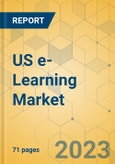Speak directly to the analyst to clarify any post sales queries you may have.
KEY HIGHLIGHTS:- The rising trend of adopting online courses and learning materials as a realistic alternative to normal classroom instruction has driven the demand for e-learning in the US region, and the industry has witnessed significant development. This has fuelled the rise in e-learning’s acceptability across all industries.
- The region's high average disposable income, growing use of smartphones, and technological advances in developing interactive and gamified learning platforms are likely to drive market expansion in user base and subscriptions. The growth of the e-learning market in the area is driven by factors such as millennials' increased buying power, increasing smartphone use, predisposition toward new technologies, and growing urbanization.
- Furthermore, the market exceeds others in innovation and certification standards, which bodes well for product development and business structure, where competitiveness is often measured in terms of involvement, degree of customization, and content quality rather than price. The price-based competition will likely intensify with the emergence of cheap subscriptions and freemium cloud goods, particularly from smaller growing enterprises.
- US surpasses big, industrialized economies on practically every criterion for e-learning deployment. In 2022, the country had a well-developed communication infrastructure, with internet penetration exceeding 91% and smartphone penetration exceeding 96%. Although the literacy rate in the country has remained steady over the previous decade, over 15% of the American population cannot read. Furthermore, 18%–21% of American adults have a reading level below the fifth grade. While all of this appears to lead to a promising future for the e-learning industry, there are several obstacles to online learning acceptance.
- The e-learning market is dominated by LMS and the language training and proficiency testing segment, followed by the higher education segment. The segment has witnessed tepid growth due to faculty and students' growing preference for interactive systems. LMS is perceived to restrict academic sharing. With limited customizations, schools often weigh them against open, customizable platforms that can be implemented faster and are offered cheaper than licensed LMS.
LIST OF VENDORSKey Vendors- Oracle
- Adobe
- Skillsoft
- Aptara
- Coursera
- Cisco
- Anthology
- Pearson
- British Council
- Udemy
Other Prominent Vendors- GP Strategies
- McGraw Hill
- D2L
- Cengage Learning
- NIIT
- Instructure
- IXL Learning
- Docebo
- Cornerstone
- edX
- Khan Academy
- Litmos
- Chegg
- Open Education
- Simplilearn
- Age of Learning
- Skillshare
- BenchPrep
- OpenSesame
REPORT HIGHLIGHTSSEGMENTATION & FORECAST- Delivery Mode (Revenue)
- Packaged Content
- Learning Management System (LMS)
- Others
- Learning Mode (Revenue)
- Self-paced
- Instructor-led
- Function (Revenue)
- Training
- Testing
- End-User (Revenue)
- Corporate
- Higher Education
- K-12
- Government
- Vocational
MARKET STRUCTURE- Market Dynamics
- Competitive Landscape of US E-Learning Market
- Key Vendors
- Other Prominent Vendors
APPENDIX- Research Methodology
- Abbreviations
- About the Analyst
Table of Contents
Companies Mentioned
- Oracle
- Adobe
- Skillsoft
- Aptara
- Coursera
- Cisco
- Anthology
- Pearson
- British Council
- Udemy
- GP Strategies
- McGraw Hill
- D2L
- Cengage Learning
- NIIT
- Instructure
- IXL Learning
- Docebo
- Cornerstone
- edX
- Khan Academy
- Litmos
- Chegg
- Open Education
- Simplilearn
- Age of Learning
- Skillshare
- BenchPrep
- OpenSesame
Methodology
Our research comprises a mix of primary and secondary research. The secondary research sources that are typically referred to include, but are not limited to, company websites, annual reports, financial reports, company pipeline charts, broker reports, investor presentations and SEC filings, journals and conferences, internal proprietary databases, news articles, press releases, and webcasts specific to the companies operating in any given market.
Primary research involves email interactions with the industry participants across major geographies. The participants who typically take part in such a process include, but are not limited to, CEOs, VPs, business development managers, market intelligence managers, and national sales managers. We primarily rely on internal research work and internal databases that we have populated over the years. We cross-verify our secondary research findings with the primary respondents participating in the study.

LOADING...
Table Information
| Report Attribute | Details |
|---|---|
| No. of Pages | 71 |
| Published | November 2023 |
| Forecast Period | 2022 - 2028 |
| Estimated Market Value ( USD | $ 87.09 Billion |
| Forecasted Market Value ( USD | $ 151.73 Billion |
| Compound Annual Growth Rate | 9.6% |
| Regions Covered | United States |
| No. of Companies Mentioned | 30 |








